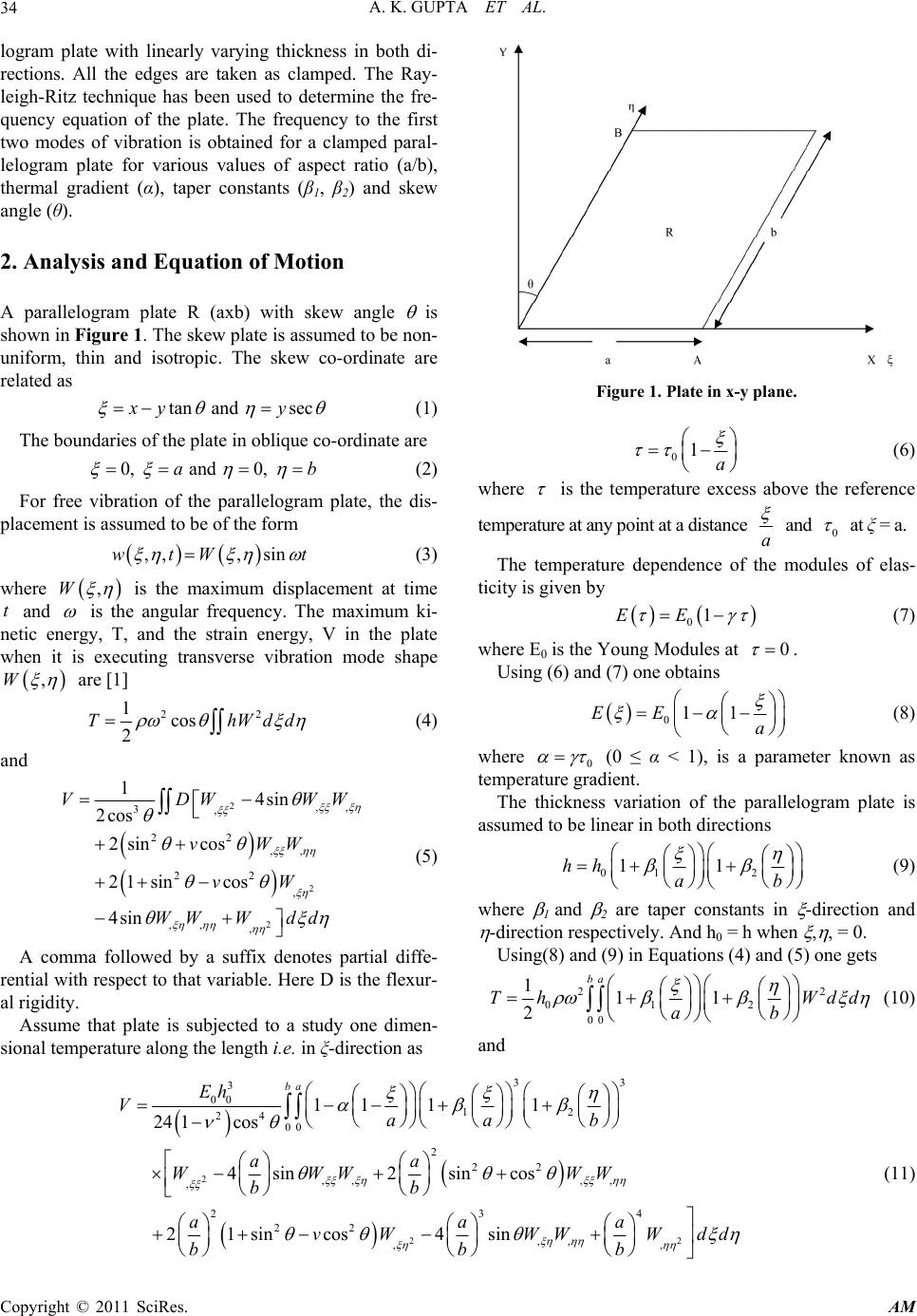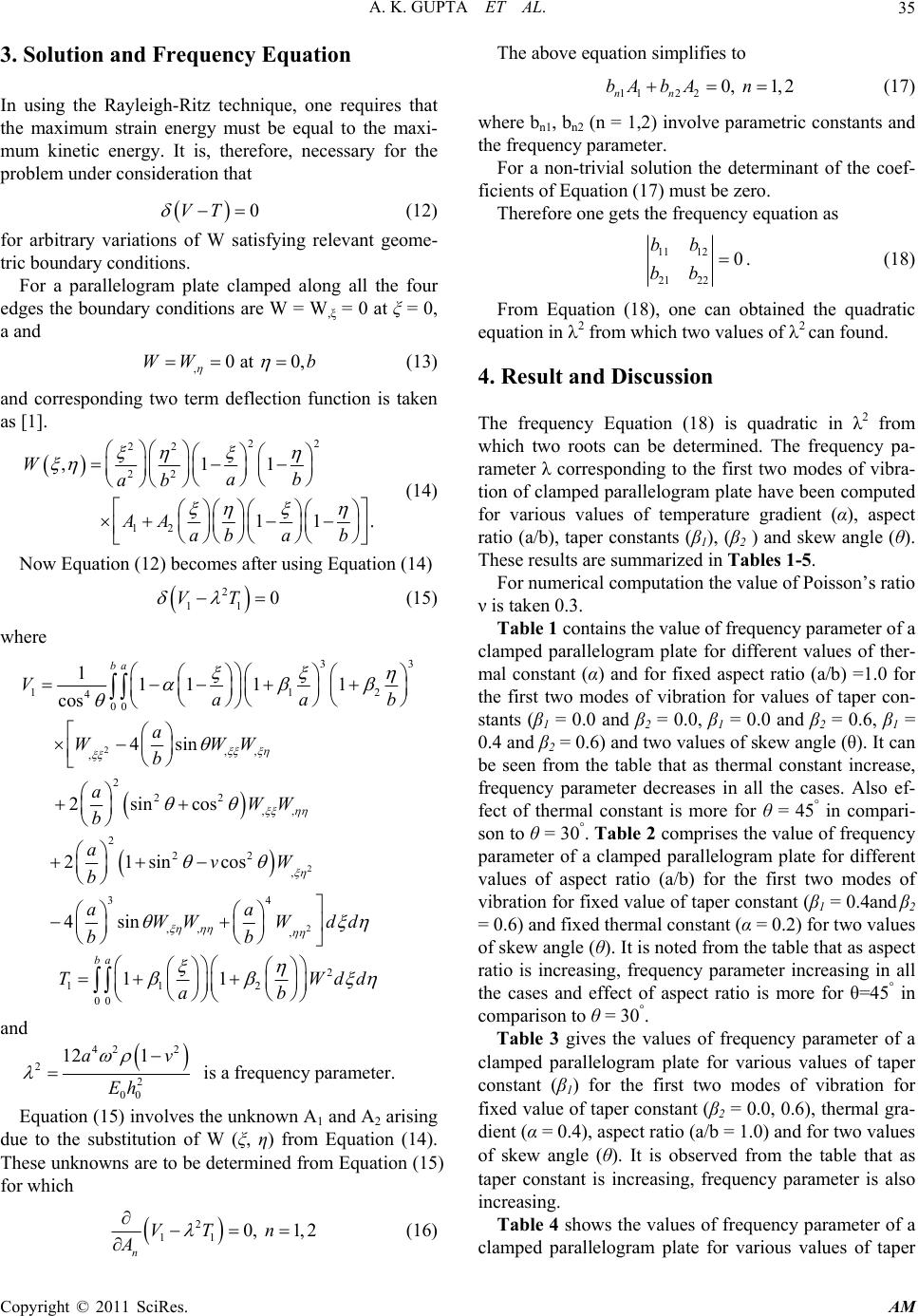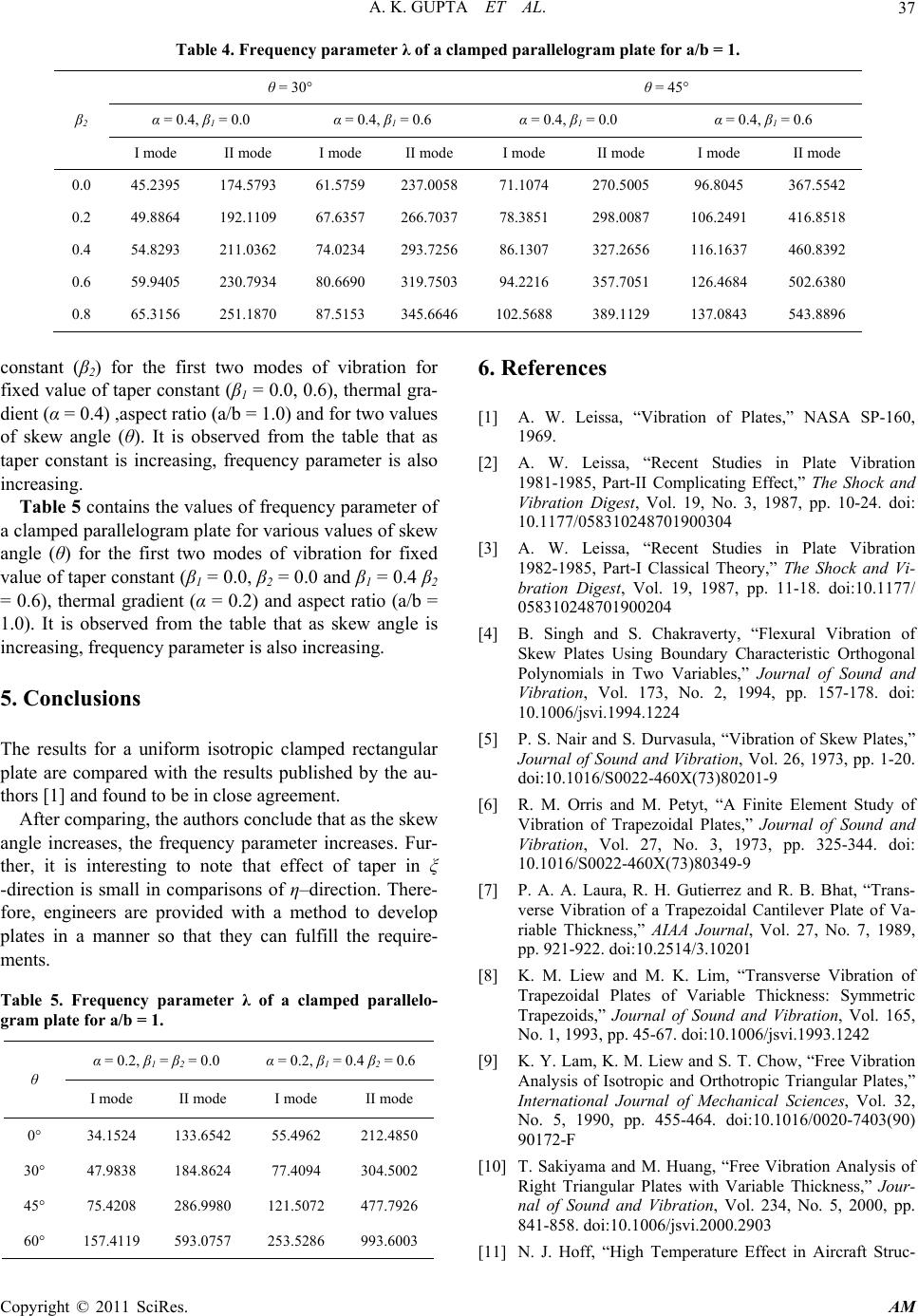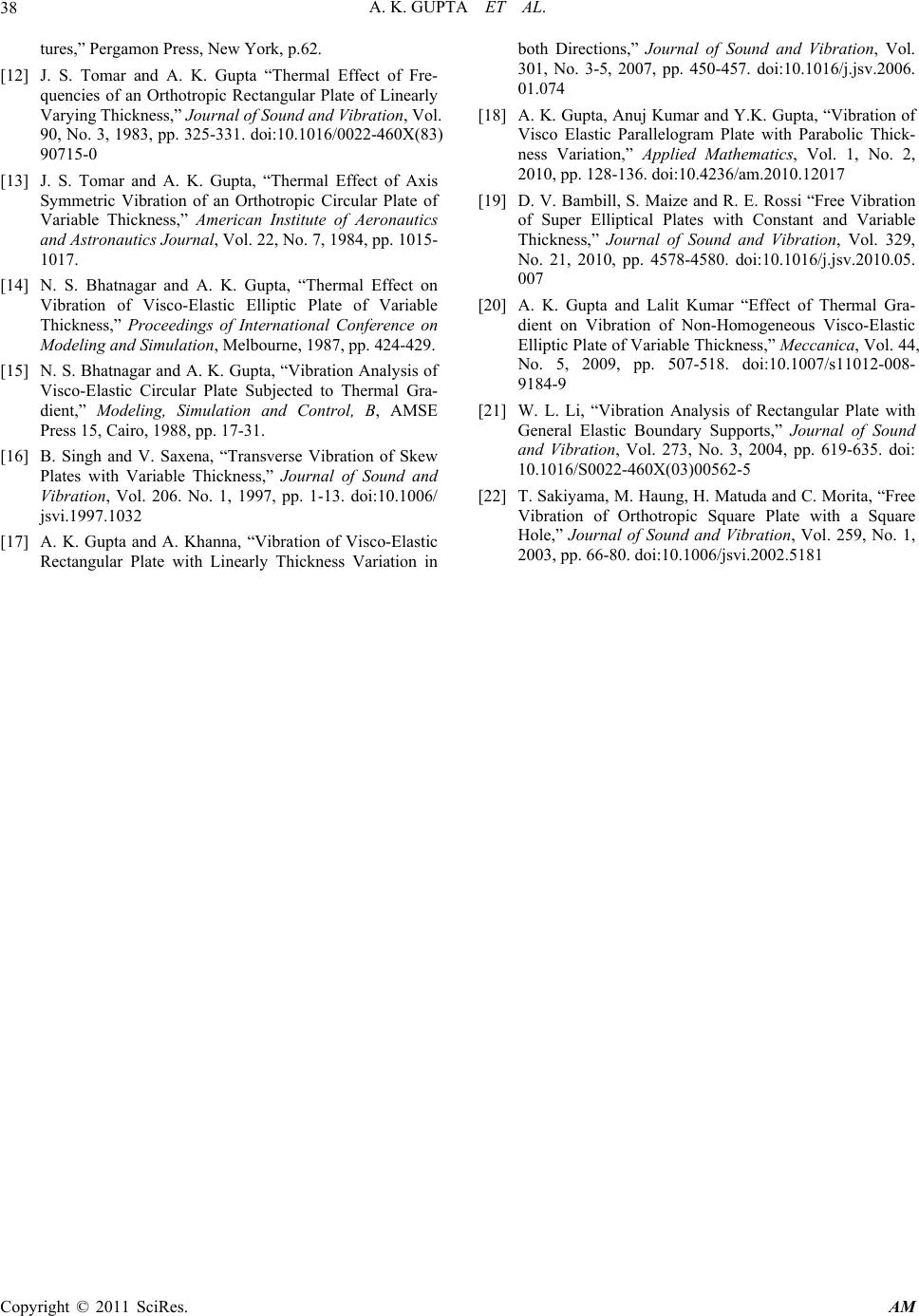Paper Menu >>
Journal Menu >>
 Applied Mathematics, 2011, 2, 33-38 doi:10.4236/am.2011.21004 Published Online January 2011 (http://www.SciRP.org/journal/am) Copyright © 2011 SciRes. AM Thermal Effect on Vibration of Parallelogram Plate of Bi-Direction Linearly Varying Thickness Arun K. Gupta1, Manoj Kumar2, Sanjay Kumar1, Anupam Khanna3 1Department of Mathematics, M S College, Saharanpur, India 2Department of Mathematics, Hermes College of Engineering and Management, Roorkee, India 3Department of Mathematics, Shobhit Institute of Engineering and Technology, Saharanpur, India E-mail: gupta_arunnitin@yahoo.co.in, manoj_garg94@ yahoo.com, sanjay70gupta@yahoo.co.in , anupam_rajie@yahoo.co.in Received September 13, 2010; revised November 3, 2010; accepted November 6, 2010 Abstract In this paper, the effect of thermal gradient on the vibration of parallelogram plate with linearly varying thickness in both direction having clamped boundary conditions on all the four edges is analyzed. Thermal effect on vibration of such plate has been taken as one-dimensional distribution in linear form only. An ap- proximate but quiet convenient frequency equation is derived using Rayleigh-Ritz technique with a two-term deflection function. The frequencies corresponding to the first two modes of vibration of a clamped paralle- logram plate have been computed for different values of aspect ratio, thermal gradient, taper constants and skew angle. The results have been presented in tabular forms. The results obtained in this study are reduced to that of unheated parallelogram plates of uniform thickness and have generally been compared with the published one. Keywords: Parallelogram Plate, Vibration, Thermal Gradient, Linearly Thickness, Both Directions 1. Introduction Parallelogram plates have quite a good number of appli- cations in modern structures. This type of plates can be found frequently in modern constructions in the form of reinforced slabs or stiffened plates. Such structures are widely used as floor in bridges, ship hulls, buildings etc. these plates are also used in the construction of wings, tails and fins of rockets and missiles. In the modern time, people have started taking lot of interest in effect of temperature on solids, as it has a lot of role in space technology, high-speed atmospheric flights and in nuclear energy applications. In the modern technology, mechanical parts of different machines have to operate high temperature, which effect efficiency. The reason for it is that during heating up period of structures exposed to high intensity heat fluxes, the material prop- erties under go significant vibrations. Notable contributions [1-10] are available on vibration of skew plate but none of them considered the thermal effect. It is well known [11] that in the presence of a constant thermal gradient, the elastic coefficients of ho- mogeneous material become functions of the space vari- able. Tomar and Gupta [12-13] have considered the ef- fect of thermal gradient of the frequency of an ortho- tropic plate of variable thickness. Bhatnagar and Gupta [14-15] have studied the effect of thermal gradient on vibration of visco-elastic plate of variable thickness. Singh and Saxena [16] have studied the transverse vibra- tion of skew plates with variable thickness. Gupta and Khanna [17] have studied the vibration of visco-elastic rectangular plate with linearly thickness variation in both directions. Gupta, Kumar and Gupta [18] have analyzed on vibration of visco-elastic parallelogram plate with parabolic thickness variation. Free vibration of super elliptical plates with constant and variable thickness by Ritz method has been discussed by Bambill, Maize and Rossi [19]. Effect of thermal gradient on vibration of non-homogeneous visco-elastic elliptical plate of varia- ble thickness has been analyzed by Gupta and Kumar [20]. Li [21] discussed the vibration analysis of rectan- gular plate with general elastic boundary supports. Sa- kiyama, Haung, Matuda and Morita [22] solved the problem of free vibration of orthotropic square plate with square hole. The aim of the present study is to find the effect of li- near thermal gradient on vibration of a clamped paralle-  A. K. GUPTA ET AL. Copyright © 2011 SciRes. AM 34 logram plate with linearly varying thickness in both di- rections. All the edges are taken as clamped. The Ray- leigh-Ritz technique has been used to determine the fre- quency equation of the plate. The frequency to the first two modes of vibration is obtained for a clamped paral- lelogram plate for various values of aspect ratio (a/b), thermal gradient (α), taper constants (β1, β2) and skew angle (θ). 2. Analysis and Equation of Motion A parallelogram plate R (axb) with skew angle is shown in Figure 1. The skew plate is assumed to be non- uniform, thin and isotropic. The skew co-ordinate are related as tan and secxy y (1) The boundaries of the plate in oblique co-ordinate are 0, and 0, ab (2) For free vibration of the parallelogram plate, the dis- placement is assumed to be of the form ,,, sinwtW t (3) where ,W is the maximum displacement at time t and is the angular frequency. The maximum ki- netic energy, T, and the strain energy, V in the plate when it is executing transverse vibration mode shape ,W are [1] 22 1cos 2 ThWdd (4) and 2 2 2 ,, 3, 22 ,, 22 , ,, , 14sin 2cos 2sincos 21sincos 4sin VDWWW vWW vW WW Wdd (5) A comma followed by a suffix denotes partial diffe- rential with respect to that variable. Here D is the flexur- al rigidity. Assume that plate is subjected to a study one dimen- sional temperature along the length i.e. in ξ-direction as Figure 1. Plate in x-y plane. 01a (6) where is the temperature excess above the reference temperature at any point at a distance a and 0 at ξ = a. The temperature dependence of the modules of elas- ticity is given by 01EE (7) where E0 is the Young Modules at 0 . Using (6) and (7) one obtains 011EE a (8) where 0 (0 ≤ α < 1), is a parameter known as temperature gradient. The thickness variation of the parallelogram plate is assumed to be linear in both directions 01 2 11hh ab (9) where 1 and 2 are taper constants in -direction and -direction respectively. And h0 = h when , , = 0. Using(8) and (9) in Equations (4) and (5) one gets 22 012 00 111 2 ba Th Wdd ab (10) and 2 2 33 3 00 12 24 00 2 22 ,, ,, , 23 22 , 11 11 24 1cos 4sin2sincos 21sincos4sin ba Eh Vaa b aa WWW WW bb aa vW W bb 2 4 ,, , a WWdd b (11)  A. K. GUPTA ET AL. Copyright © 2011 SciRes. AM 35 3. Solution and Frequency Equation In using the Rayleigh-Ritz technique, one requires that the maximum strain energy must be equal to the maxi- mum kinetic energy. It is, therefore, necessary for the problem under consideration that 0VT (12) for arbitrary variations of W satisfying relevant geome- tric boundary conditions. For a parallelogram plate clamped along all the four edges the boundary conditions are W = W,ξ = 0 at ξ = 0, a and ,0 at 0,WW b (13) and corresponding two term deflection function is taken as [1]. 22 22 22 12 ,11 11. Wab ab AA ab ab (14) Now Equation (12) becomes after using Equation (14) 2 11 0VT (15) where 2 2 33 112 4 00 ,, , 2 22 ,, 2 22 , 3 ,, 111 11 cos 4sin 2sincos 21sincos 4sin ba Vaab a WWW b aWW b avW b aa WW bb 2 4 , Wdd 2 11 2 00 11 ba TWdd ab and 42 2 2 2 00 12 1av Eh is a frequency parameter. Equation (15) involves the unknown A1 and A2 arising due to the substitution of W (ξ, η) from Equation (14). These unknowns are to be determined from Equation (15) for which 2 11 0, 1,2 n VT n A (16) The above equation simplifies to 112 20, 1,2 nn bAb An (17) where bn1, bn2 (n = 1,2) involve parametric constants and the frequency parameter. For a non-trivial solution the determinant of the coef- ficients of Equation (17) must be zero. Therefore one gets the frequency equation as 11 12 21 22 0 bb bb . (18) From Equation (18), one can obtained the quadratic equation in 2 from which two values of 2 can found. 4. Result and Discussion The frequency Equation (18) is quadratic in λ2 from which two roots can be determined. The frequency pa- rameter λ corresponding to the first two modes of vibra- tion of clamped parallelogram plate have been computed for various values of temperature gradient (α), aspect ratio (a/b), taper constants (β1), (β2 ) and skew angle (θ). These results are summarized in Tables 1-5. For numerical computation the value of Poisson’s ratio ν is taken 0.3. Table 1 contains the value of frequency parameter of a clamped parallelogram plate for different values of ther- mal constant (α) and for fixed aspect ratio (a/b) =1.0 for the first two modes of vibration for values of taper con- stants (β1 = 0.0 and β2 = 0.0, β1 = 0.0 and β2 = 0.6, β1 = 0.4 and β2 = 0.6) and two values of skew angle (θ). It can be seen from the table that as thermal constant increase, frequency parameter decreases in all the cases. Also ef- fect of thermal constant is more for θ = 45° in compari- son to θ = 30°. Table 2 comprises the value of frequency parameter of a clamped parallelogram plate for different values of aspect ratio (a/b) for the first two modes of vibration for fixed value of taper constant (β1 = 0.4and β2 = 0.6) and fixed thermal constant (α = 0.2) for two values of skew angle (θ). It is noted from the table that as aspect ratio is increasing, frequency parameter increasing in all the cases and effect of aspect ratio is more for θ=45° in comparison to θ = 30°. Table 3 gives the values of frequency parameter of a clamped parallelogram plate for various values of taper constant (β1) for the first two modes of vibration for fixed value of taper constant (β2 = 0.0, 0.6), thermal gra- dient (α = 0.4), aspect ratio (a/b = 1.0) and for two values of skew angle (θ). It is observed from the table that as taper constant is increasing, frequency parameter is also increasing. Table 4 shows the values of frequency parameter of a clamped parallelogram plate for various values of taper  A. K. GUPTA ET AL. Copyright © 2011 SciRes. AM 36 Table 1. Frequency parameter λ of a clamped parallelogram plate for a/b = 1.0. θ = 30° α β1 = β2 = 0.0 β1 = 0.0, β2 = 0.6 β1 = 0.4, β2 = 0.6 I mode II mode I mode II mode I mode II mode 0.0 61.4283 236.5564 67.2606 258.9453 81.1022 318.4257 0.2 58.7339 226.1332 63.7993 245.2736 77.4094 304.5002 0.4 55.9060 215.2066 59.9905 230.7934 73.5239 289.9084 0.6 52.9215 203.6964 56.0027 215.3417 69.4106 274.5449 0.8 49.7499 191.4977 51.7080 198.6919 65.0218 258.2730 θ = 45° β1 = β2 = 0.0 β1 = 0.0, β2 = 0.6 β1 = 0.4, β2 = 0.6 I mode II mode I mode II mode I mode II mode 79.5005 302.5225 105.7948 401.7948 127.3479 499.3421 75.4208 286.9980 100.1417 380.3892 121.5072 477.7926 71.1074 270.5844 94.2215 357.7051 115.3581 455.2276 66.5149 253.1086 87.9034 333.4815 108.8434 431.4886 61.5808 234.3329 81.0943 307.3547 101.8854 406.3723 Table 2. Frequency parameter λ of a clamped parallelogram plate for β1 = 0.4, β2 = 0.6, α = 0.2. a/b θ = 30° θ = 45° I mode II mode I mode II mode 0.5 51.8014 206.8539 121.7636 316.5569 1.0 77.4094 304.5002 121.5072 477.7926 1.5 129.6335 514.0130 201.7746 804.2516 2.0 207.3843 827.5726 319.2430 1283.8269 2.5 309.2726 1237.4373 472.4142 1906.5696 Table 3. Frequency parameter λ of a clamped parallelogram plate for a/b = 1. β1 θ = 30° θ = 45° α = 0.4, β2 = 0.0 α= 0.4, β2 = 0.6 α = 0.4, β2 = 0.0 α = 0.4, β2 = 0.6 I mode II mode I mode II mode I mode II mode I mode II mode 0.0 45.2395 174.2904 59.9905 230.7934 71.1074 270.5843 94.2216 357.7051 0.2 50.4341 194.2100 66.6139 260.3359 79.2771 301.4143 104.5958 407.2275 0.4 55.9060 215.2067 73.5239 289.9084 87.8845 333.8754 115.3581 455.2276 0.6 61.5759 237.0058 80.6690 319.7503 96.8045 367.5542 126.4684 502.6380 0.8 67.3896 259.413 88.0023 349.9568 105.9515 402.1589 137.8679 549.9366  A. K. GUPTA ET AL. Copyright © 2011 SciRes. AM 37 Table 4. Frequency parameter λ of a clamped parallelogram plate for a/b = 1. β2 θ = 30° θ = 45° α = 0.4, β1 = 0.0 α = 0.4, β1 = 0.6 α = 0.4, β1 = 0.0 α = 0.4, β1 = 0.6 I mode II mode I mode II mode I mode II mode I mode II mode 0.0 45.2395 174.5793 61.5759 237.0058 71.1074 270.5005 96.8045 367.5542 0.2 49.8864 192.1109 67.6357 266.703778.3851 298.0087 106.2491 416.8518 0.4 54.8293 211.0362 74.0234 293.725686.1307 327.2656 116.1637 460.8392 0.6 59.9405 230.7934 80.6690 319.750394.2216 357.7051 126.4684 502.6380 0.8 65.3156 251.1870 87.5153 345.6646102.5688 389.1129 137.0843 543.8896 constant (β2) for the first two modes of vibration for fixed value of taper constant (β1 = 0.0, 0.6), thermal gra- dient (α = 0.4) ,aspect ratio (a/b = 1.0) and for two values of skew angle (θ). It is observed from the table that as taper constant is increasing, frequency parameter is also increasing. Table 5 contains the values of frequency parameter of a clamped parallelogram plate for various values of skew angle (θ) for the first two modes of vibration for fixed value of taper constant (β1 = 0.0, β2 = 0.0 and β1 = 0.4 β2 = 0.6), thermal gradient (α = 0.2) and aspect ratio (a/b = 1.0). It is observed from the table that as skew angle is increasing, frequency parameter is also increasing. 5. Conclusions The results for a uniform isotropic clamped rectangular plate are compared with the results published by the au- thors [1] and found to be in close agreement. After comparing, the authors conclude that as the skew angle increases, the frequency parameter increases. Fur- ther, it is interesting to note that effect of taper in ξ -direction is small in comparisons of η–direction. There- fore, engineers are provided with a method to develop plates in a manner so that they can fulfill the require- ments. Table 5. Frequency parameter λ of a clamped parallelo- gram plate for a/b = 1. θ α = 0.2, β1 = β2 = 0.0 α = 0.2, β1 = 0.4 β2 = 0.6 I mode II mode I mode II mode 0° 34.1524 133.6542 55.4962 212.4850 30° 47.9838 184.8624 77.4094 304.5002 45° 75.4208 286.9980 121.5072 477.7926 60° 157.4119 593.0757 253.5286 993.6003 6. References [1] A. W. Leissa, “Vibration of Plates,” NASA SP-160, 1969. [2] A. W. Leissa, “Recent Studies in Plate Vibration 1981-1985, Part-II Complicating Effect,” The Shock and Vibration Digest, Vol. 19, No. 3, 1987, pp. 10-24. doi: 10.1177/058310248701900304 [3] A. W. Leissa, “Recent Studies in Plate Vibration 1982-1985, Part-I Classical Theory,” The Shock and Vi- bration Digest, Vol. 19, 1987, pp. 11-18. doi:10.1177/ 058310248701900204 [4] B. Singh and S. Chakraverty, “Flexural Vibration of Skew Plates Using Boundary Characteristic Orthogonal Polynomials in Two Variables,” Journal of Sound and Vibration, Vol. 173, No. 2, 1994, pp. 157-178. doi: 10.1006/jsvi.1994.1224 [5] P. S. Nair and S. Durvasula, “Vibration of Skew Plates,” Journal of Sound and Vibration, Vol. 26, 1973, pp. 1-20. doi:10.1016/S0022-460X(73)80201-9 [6] R. M. Orris and M. Petyt, “A Finite Element Study of Vibration of Trapezoidal Plates,” Journal of Sound and Vibration, Vol. 27, No. 3, 1973, pp. 325-344. doi: 10.1016/S0022-460X(73)80349-9 [7] P. A. A. Laura, R. H. Gutierrez and R. B. Bhat, “Trans- verse Vibration of a Trapezoidal Cantilever Plate of Va- riable Thickness,” AIAA Journal, Vol. 27, No. 7, 1989, pp. 921-922. doi:10.2514/3.10201 [8] K. M. Liew and M. K. Lim, “Transverse Vibration of Trapezoidal Plates of Variable Thickness: Symmetric Trapezoids,” Journal of Sound and Vibration, Vol. 165, No. 1, 1993, pp. 45-67. doi:10.1006/jsvi.1993.1242 [9] K. Y. Lam, K. M. Liew and S. T. Chow, “Free Vibration Analysis of Isotropic and Orthotropic Triangular Plates,” International Journal of Mechanical Sciences, Vol. 32, No. 5, 1990, pp. 455-464. doi:10.1016/0020-7403(90) 90172-F [10] T. Sakiyama and M. Huang, “Free Vibration Analysis of Right Triangular Plates with Variable Thickness,” Jour- nal of Sound and Vibration, Vol. 234, No. 5, 2000, pp. 841-858. doi:10.1006/jsvi.2000.2903 [11] N. J. Hoff, “High Temperature Effect in Aircraft Struc-  A. K. GUPTA ET AL. Copyright © 2011 SciRes. AM 38 tures,” Pergamon Press, New York, p.62. [12] J. S. Tomar and A. K. Gupta “Thermal Effect of Fre- quencies of an Orthotropic Rectangular Plate of Linearly Varying Thickness,” Journal of Sound and Vibration, Vol. 90, No. 3, 1983, pp. 325-331. doi:10.1016/0022-460X(83) 90715-0 [13] J. S. Tomar and A. K. Gupta, “Thermal Effect of Axis Symmetric Vibration of an Orthotropic Circular Plate of Variable Thickness,” American Institute of Aeronautics and Astronautics Journal, Vol. 22, No. 7, 1984, pp. 1015- 1017. [14] N. S. Bhatnagar and A. K. Gupta, “Thermal Effect on Vibration of Visco-Elastic Elliptic Plate of Variable Thickness,” Proceedings of International Conference on Modeling and Simulation, Melbourne, 1987, pp. 424-429. [15] N. S. Bhatnagar and A. K. Gupta, “Vibration Analysis of Visco-Elastic Circular Plate Subjected to Thermal Gra- dient,” Modeling, Simulation and Control, B, AMSE Press 15, Cairo, 1988, pp. 17-31. [16] B. Singh and V. Saxena, “Transverse Vibration of Skew Plates with Variable Thickness,” Journal of Sound and Vibration, Vol. 206. No. 1, 1997, pp. 1-13. doi:10.1006/ jsvi.1997.1032 [17] A. K. Gupta and A. Khanna, “Vibration of Visco-Elastic Rectangular Plate with Linearly Thickness Variation in both Directions,” Journal of Sound and Vibration, Vol. 301, No. 3-5, 2007, pp. 450-457. doi:10.1016/j.jsv.2006. 01.074 [18] A. K. Gupta, Anuj Kumar and Y.K. Gupta, “Vibration of Visco Elastic Parallelogram Plate with Parabolic Thick- ness Variation,” Applied Mathematics, Vol. 1, No. 2, 2010, pp. 128-136. doi:10.4236/am.2010.12017 [19] D. V. Bambill, S. Maize and R. E. Rossi “Free Vibration of Super Elliptical Plates with Constant and Variable Thickness,” Journal of Sound and Vibration, Vol. 329, No. 21, 2010, pp. 4578-4580. doi:10.1016/j.jsv.2010.05. 007 [20] A. K. Gupta and Lalit Kumar “Effect of Thermal Gra- dient on Vibration of Non-Homogeneous Visco-Elastic Elliptic Plate of Variable Thickness,” Meccanica, Vol. 44, No. 5, 2009, pp. 507-518. doi:10.1007/s11012-008- 9184-9 [21] W. L. Li, “Vibration Analysis of Rectangular Plate with General Elastic Boundary Supports,” Journal of Sound and Vibration, Vol. 273, No. 3, 2004, pp. 619-635. doi: 10.1016/S0022-460X(03)00562-5 [22] T. Sakiyama, M. Haung, H. Matuda and C. Morita, “Free Vibration of Orthotropic Square Plate with a Square Hole,” Journal of Sound and Vibration, Vol. 259, No. 1, 2003, pp. 66-80. doi:10.1006/jsvi.2002.5181 |

